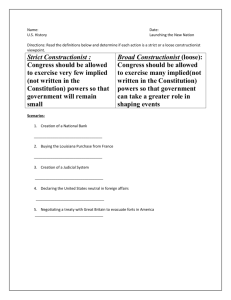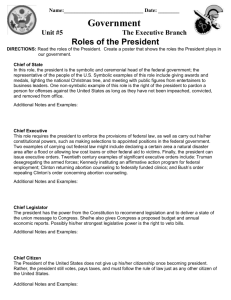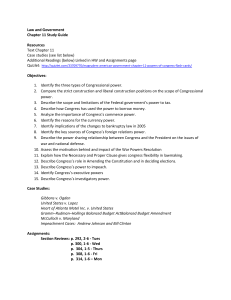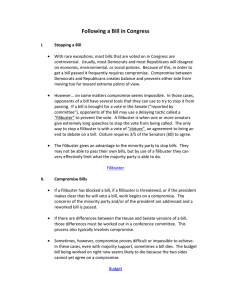American Government
advertisement
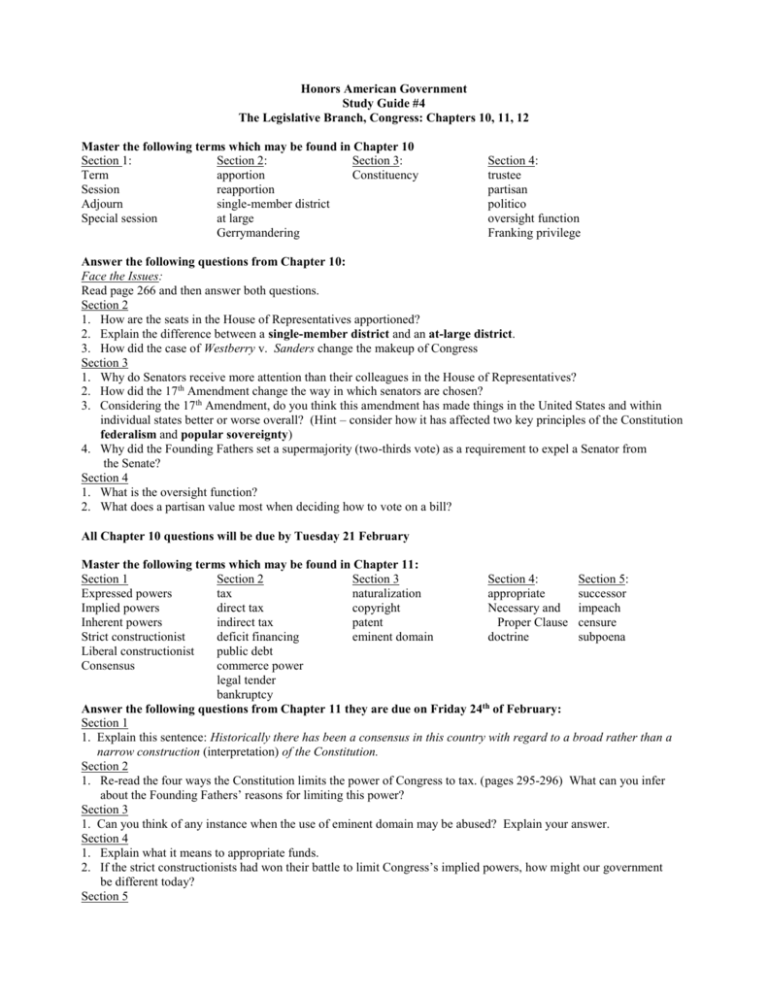
Honors American Government Study Guide #4 The Legislative Branch, Congress: Chapters 10, 11, 12 Master the following terms which may be found in Chapter 10 Section 1: Section 2: Section 3: Term apportion Constituency Session reapportion Adjourn single-member district Special session at large Gerrymandering Section 4: trustee partisan politico oversight function Franking privilege Answer the following questions from Chapter 10: Face the Issues: Read page 266 and then answer both questions. Section 2 1. How are the seats in the House of Representatives apportioned? 2. Explain the difference between a single-member district and an at-large district. 3. How did the case of Westberry v. Sanders change the makeup of Congress Section 3 1. Why do Senators receive more attention than their colleagues in the House of Representatives? 2. How did the 17th Amendment change the way in which senators are chosen? 3. Considering the 17th Amendment, do you think this amendment has made things in the United States and within individual states better or worse overall? (Hint – consider how it has affected two key principles of the Constitution federalism and popular sovereignty) 4. Why did the Founding Fathers set a supermajority (two-thirds vote) as a requirement to expel a Senator from the Senate? Section 4 1. What is the oversight function? 2. What does a partisan value most when deciding how to vote on a bill? All Chapter 10 questions will be due by Tuesday 21 February Master the following terms which may be found in Chapter 11: Section 1 Section 2 Section 3 Section 4: Section 5: Expressed powers tax naturalization appropriate successor Implied powers direct tax copyright Necessary and impeach Inherent powers indirect tax patent Proper Clause censure Strict constructionist deficit financing eminent domain doctrine subpoena Liberal constructionist public debt Consensus commerce power legal tender bankruptcy Answer the following questions from Chapter 11 they are due on Friday 24th of February: Section 1 1. Explain this sentence: Historically there has been a consensus in this country with regard to a broad rather than a narrow construction (interpretation) of the Constitution. Section 2 1. Re-read the four ways the Constitution limits the power of Congress to tax. (pages 295-296) What can you infer about the Founding Fathers’ reasons for limiting this power? Section 3 1. Can you think of any instance when the use of eminent domain may be abused? Explain your answer. Section 4 1. Explain what it means to appropriate funds. 2. If the strict constructionists had won their battle to limit Congress’s implied powers, how might our government be different today? Section 5 1. During the Clinton impeachment hearings and trial, members of Congress from both parties were accused of excessive partisanship. A. Explain this accusation. B. What evidence might support this claim? The answers to the questions from Chapter 11 will be due on Wednesday 29th February: and there will be a vocabulary quiz as well. Master the following terms which may be found in Chapter 12: Section 1: Section 2: Section 3: Section 4: Speaker of the House standing committee bill filibuster president of the Senate select committee joint resolution cloture president pro tempore joint committee concurrent resolution veto party caucus conference committee resolution pocket veto floor leader rider whip discharge petition committee chairman Committee of the Whole seniority rule quorum engrossed The answers to the questions from Chapter 12 will be due on Tuesday March 6thth and there will be a vocabulary quiz as well. Section 1 1. What role does the Speaker of the House play? 2. What factors make committee chairman so influential? Section 2 1. How do joint committees differ from conference committees? 2. Where is the real work of Congress done; in committee or when they are in session as an entire body? Why? Section 3 1. Why do members of Congress attach riders to bills that are almost certain to pass? Would the Founding Fathers approve or disapprove of this tactic? 2. What is a quorum and why must it be present to conduct business? Section 4 1. Explain how a filibuster is supposed to work. How is a filibuster used today? 2. What is cloture and why is it hard to obtain? The Test will be on Thursday March 8th



